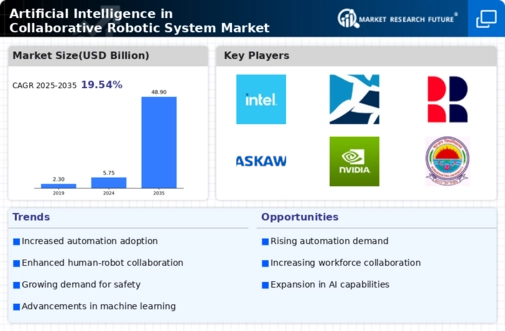Advancements in AI Technologies
Technological advancements in artificial intelligence are significantly influencing the Artificial Intelligence in Collaborative Robotic System Market. Innovations in machine learning, computer vision, and natural language processing are enabling robots to perform complex tasks with greater accuracy and efficiency. For instance, the implementation of deep learning algorithms allows robots to learn from their environments and adapt to new situations autonomously. This adaptability is crucial in sectors such as logistics and healthcare, where robots must interact with dynamic environments. The market for AI technologies is expected to grow substantially, with estimates suggesting a compound annual growth rate of over 20% in the coming years. Such advancements are likely to enhance the functionality and application scope of collaborative robots, driving their adoption across various industries.
Increased Focus on Workplace Safety
The heightened emphasis on workplace safety is a significant driver for the Artificial Intelligence in Collaborative Robotic System Market. As organizations prioritize the well-being of their employees, the integration of collaborative robots is seen as a viable solution to mitigate risks associated with manual labor. Cobots are designed to operate safely alongside human workers, reducing the likelihood of accidents and injuries. Data indicates that workplaces utilizing collaborative robots have reported a decrease in injury rates by up to 30%. This focus on safety not only enhances employee morale but also leads to increased productivity. Consequently, the demand for AI-driven collaborative robots is expected to rise as companies seek to create safer working environments while maintaining operational efficiency.
Rising Demand for Automation in Manufacturing
The increasing demand for automation in manufacturing processes is a primary driver for the Artificial Intelligence in Collaborative Robotic System Market. As industries strive for enhanced efficiency and productivity, the integration of AI-driven collaborative robots is becoming essential. According to recent data, the manufacturing sector is projected to witness a growth rate of approximately 10% annually, with AI technologies playing a pivotal role in this transformation. Collaborative robots, or cobots, are designed to work alongside human operators, thereby improving safety and reducing operational costs. This trend indicates a shift towards more intelligent manufacturing systems, where AI enhances the capabilities of collaborative robots, making them indispensable in modern production environments.
Customization and Flexibility in Robotic Solutions
The demand for customizable and flexible robotic solutions is driving growth in the Artificial Intelligence in Collaborative Robotic System Market. Businesses are increasingly seeking robots that can be tailored to specific tasks and workflows, allowing for greater adaptability in production lines. This trend is particularly evident in sectors such as automotive and electronics, where unique manufacturing processes require specialized robotic solutions. The ability to program and reconfigure collaborative robots for various applications enhances their utility and appeal. Market analysis suggests that the customization segment is expected to grow at a rate of 15% annually, reflecting the industry's shift towards more versatile robotic systems. This flexibility not only meets the diverse needs of manufacturers but also fosters innovation in product development.
Growing Investment in Robotics Research and Development
The surge in investment in robotics research and development is a crucial driver for the Artificial Intelligence in Collaborative Robotic System Market. Governments and private entities are increasingly allocating funds to advance robotic technologies, particularly those that incorporate AI. This investment is aimed at enhancing the capabilities of collaborative robots, making them more efficient and effective in various applications. Recent reports indicate that global spending on robotics R&D is expected to exceed $100 billion by 2027, highlighting the commitment to innovation in this field. Such financial backing is likely to accelerate the development of next-generation collaborative robots, which will further expand their applications across industries, from manufacturing to healthcare.


















Leave a Comment